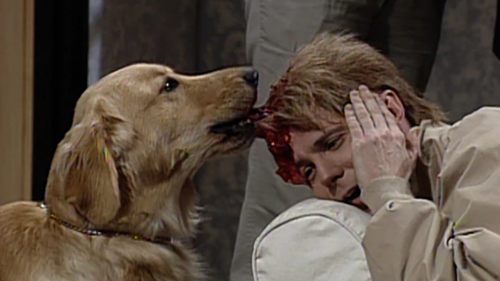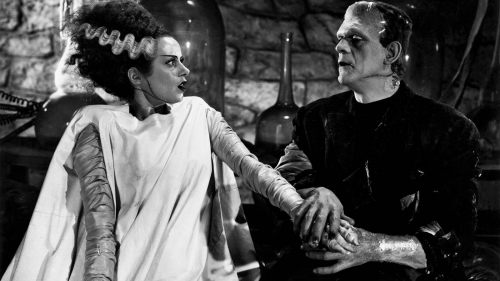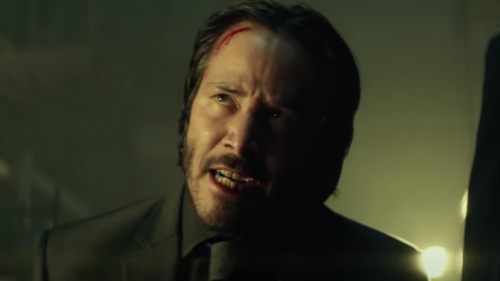EXIT THROUGH THE GIFT SHOP, Ten Years Later
For a brief, thrilling moment in early 2011, the glitz and glamour that usually accompany the Academy Awards sported an unlikely edge of danger. Street artist Banksy had scored a Best Documentary Feature nomination for his boundary-blurring EXIT THROUGH THE GIFT SHOP, leaving the public to wonder what might happen next. A notorious prankster vocally contemptuous of institutions and wealth, he was bound to pull a fast one on Hollywood’s biggest night, and he’d spent the days preceding the ceremony bopping around Los Angeles tagging walls and billboards.
But all the excitement was for naught; Banksy didn’t win the statuette, or even attend, after the Academy forbade him from appearing incognito. (“The fun but disquieting scenario is that if the film wins and five guys in monkey masks come to the stage all saying, ‘I'm Banksy,' who the hell do we give it to?” said the Academy’s executive director. ‘Fun’ was the operative word, you fool!) At any rate, the battle had already been won. Banksy left his mark on the mainstream and forced even the staunchest cynics to recognize the significance of the street art movement he made his own.
A bracing firsthand account of an artistic moment characterized by anarchy, EXIT THROUGH THE GIFT SHOP spray-painted a big middle finger on arthouse movie theaters ten years ago this week. The film’s unusual structure, in which a perspective-flip at the halfway point raises questions about authorship and veracity, caused plenty of ink spillage at the time. That conversation has advanced to more specific and complex places in the years since, leaving a viewer revisiting the film today mainly with the impression of a double character portrait. The cameras make a two-course meal out of Thierry Guetta, an eccentric Frenchman whose home videos of his interlope into the street art scene form the first half of EXIT THROUGH THE GIFT SHOP, and Banksy, who takes over and turns the lens on Guetta as he reinvents himself under the nom de spraycan of Mister Brainwash.
With the combination of incompetence and egotism he brings to his entrée into the art circuit, Guetta makes for a captivating subject. Banksy, however, steals the show. From the opening card for his production company Paranoid Pictures, complete with bullet holes replacing the stars of the Paramount logo he’s aping, the whole film functions as a showcase for Banksy’s sensibility and an endorsement for his street cred. At the time, it all felt so daring, an attitude quickly cemented by the masterful opening montage to Richard Hawley’s “Tonight the Streets Are Ours” depicting hoodlum artists scaling buildings and evading cops. They’re lawless and free and Banksy is their trickster-demon king, a guy so committed that he plastered up some of his own paintings in the Tate Modern.
That’s Banksy’s proper introduction to the film, infiltrating the most respected museum in England and leaving his mark. But I only noticed this time around that the painting itself isn’t much to look at; it’s a Renaissance-looking portrait, except the fair-complexioned lass has been festooned with a gas mask. The placement in the Tate’s august halls makes important that which would otherwise be pretty amateur-hour art. Look closer through the 20/20 vision of hindsight, and Banksy’s pieces start to pale in comparison to their context. Two cops kissing scans more as laddish gay-panic than any subversive anti-police statement. What is the oft-reproduced bouquet-tossing rioter trying to say to us? “Make love, not war?” If this art’s creation and exhibition wasn’t illegal, nobody would’ve given a damn.
A lot of art lovers have woken up to this notion over the past decade, as Banksy has turned into a literal punch line on Twitter. His political stances of anti-corporatism and anti-authoritarianism were betrayed first by their vagary, and then by their hypocrisy. One of the film’s main set pieces, for instance, sees Banksy slipping into a Disneyland display and installing an inflatable Guantanamo prisoner by the Thunder Mountain ride. In the moment, it’s great fun to watch how his one act incurs the full wrath of the Disney machine, which instantly halts the speeding train and drags accomplice Guetta into The Happiest Holding Cell on Earth for four hours. But aside from making Disney mad, a perfectly noble pursuit if ever there was one, the prisoner doesn’t convey anything that hasn’t been conveyed already, and in more pointed terms. Disney, Banksy’s greatest foe for the smiley face they plaster over their sinister corporate doings, would ultimately spell the artist’s downfall. His 2015 “Dismaland” exhibition would be his waterloo, a massive kiss-off to the Mouse House well-attended by celebs but pilloried by critics for its “easy sarcasm.” But even if he didn’t have many statements, people were eager to listen; the guy who came up decrying the crass commodification of creative expression has since grown very rich licensing his work for prints and other merch.
The last ten years have caught up with Banksy as they’ve caught up with the street art movement. He’s not the only one who shed his outsider persona the second dollar signs popped into his eyes; Kaws, a fellow street urchin coming up defacing Mickey Mouse and other kiddie iconography, has elevated selling out to an art form all its own with his many commercial collaborations. (My favorite: appearing on the Bravo reality series WORK OF ART: THE NEXT GREAT ARTIST as a guest judge.) Moreover, much of the buzz surrounding the so-called “street art” movement failed to account for the decades of street art called graffiti, exposing an unsavory racial tilt to how artistic legitimacy — and money — get bestowed.
EXIT THROUGH THE GIFT SHOP remains a chronicle of its era, just not in the way Banksy thought it would be. Its many nested put-ons finally enveloped him, recasting him as a huckster not so far removed from the integrity-bankrupt Mister Brainwash. That might be his most ingenious mischief of all; having found the one guy who would make him look profound by comparison.



